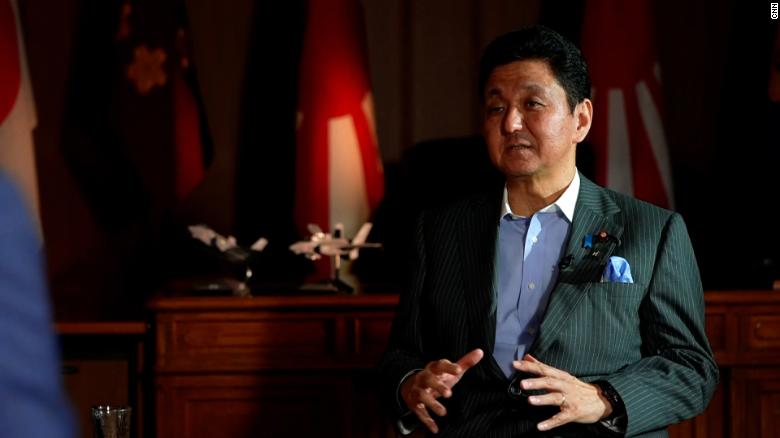Sorry, nothing in cart.
Japans’s defense minister draws red line in island dispute with Chinas
Japan’s defense minister draws red line in island dispute with China
Japan is drawing a red line around an island chain also claimed by China, pushing back at Beijing’s increasingly aggressive military posturing, and setting the stage for a potential showdown between the region’s two biggest powers.
In an exclusive interview with CNN, Japanese Defense Minister Nobuo Kishi said the Senkaku Islands, known as the Diaoyu Islands in China, are unquestionably Japanese territory and would be defended as such, with Tokyo matching any Chinese threat to the islands ship for ship, and beyond if necessary.
Japan has been expanding its Self-Defense Forces, adding state-of-the-art F-35 fighter jets and converting warships to aircraft carriers for them. It is also building new destroyers, submarines and missiles, all the while noting its military expenditure still pales in comparison with China’s increased military spending.
“Against Chinese action to Senkaku Islands and other parts of the East China Sea … we have to demonstrate that the government of Japan is resolutely defending our territory with the greater number of Japanese coast guard vessels than that of China,” Kishi said. “There is no territorial dispute relating to the Senkaku Islands between Japan and other countries,” he added.
Tensions over the uninhabited rocky chain — 1,200 miles (1,900 kilometers) southwest of Tokyo but only a third of that distance from Shanghai — have simmered for years, and claims over them date back centuries.
When tensions spiked over the islands in 2012, it sparked a groundswell of nationalist sentiment in China. Public protests broke out in dozens of Chinese cities, with Japanese-branded cars smashed, Japanese stores and restaurants vandalized, and debris hurled at the Japanese Embassy in Beijing.
At the governmental level, China has been just as strident as Kishi is in claiming the island chain.

“The Diaoyu Island and its affiliated islands are an inherent part of China’s territory, and it is our inherent right to carry out patrols and law enforcement activities in these waters,” China’s Foreign Ministry said in a statement last year.
China has been backing its claims in the region with its ships, and by establishing new laws that give its coast guard expanded powers.
According to Japanese authorities, Chinese Coast Guard vessels have ventured into Japanese territorial waters, or within 12 nautical miles of Japanese land, a total of 88 times between January 1 and the end of August. While in the contiguous zone, waters between islands but not within 12 miles of shore, there have been 851 Chinese incursions.
Experts say China’s strategy is to put its forces in places in and around contested areas and exert Beijing’s law and authority over them. Such action makes the Chinese claims seem like due course.
“Exercising coastal state rights is an important step in corroborating sovereignty through practice,” said Alessio Patalano, professor of war and strategy at King’s College in London.
Kishi has taken notice.

“There are actions that continue to challenge an integral part of Japan’s sovereign territory. These actions are making it a fait accompli,” he said.
That “integral” Japanese territory extends even closer to another possible flashpoint in the Japan-China relationship.
Taiwan’s importance to Japan

When Tokyo released its annual defense white paper in July, it contained its strongest language ever on Taiwan, saying “stabilizing the situation surrounding Taiwan is important for Japan’s security.”
At the time, Kishi said it should be monitored with “a sense of crisis.”
In his interview with CNN, he gave specifics.
“What’s happening in Taiwan is directly linked to Japan,” he said, noting the island sits astride his country’s “energy lifeline.”
“Ninety percent of energy that Japan uses is imported through the areas around Taiwan,” Kishi said.
It’s a vulnerability that Tokyo has to mitigate.
“What could happen in Taiwan could likely be an issue for Japan, and in that case, Japan will have to take the necessary response to that situation,” Kishi said, while stressing that tension should be diffused through dialogue, not violence.
But Tokyo isn’t just using words to back up its claims. It’s also beefing up its military defenses, putting missiles and troops on Yonaguni and planning to do the same to nearby Ishigaki in the near future.
“This is to demonstrate our strong will to defend our southwestern area of Japanese territory,” Kishi said.
In that regard, Tokyo has a key ally in its corner, the United States.
Tokyo and Washington share a mutual defense treaty, meaning the US is obligated to defend Japanese territory.
US President Joe Biden reaffirmed that security commitment shortly after his inauguration in January, with a White House statement specifically mentioning the Senkakus.
Kishi said this week that alliance is being strengthened, and in commenting on the Senkakus situation, said Washington has Tokyo’s back.
While lining up partners, Japan is also improving its own arsenal, including developing and acquiring weapons systems that can strike areas well beyond Japanese territory.
Without saying what areas those longer range systems might target, the Japanese defense minister said it was important for the country’s military to have the right equipment to defend it from any threat.


Leave a Reply